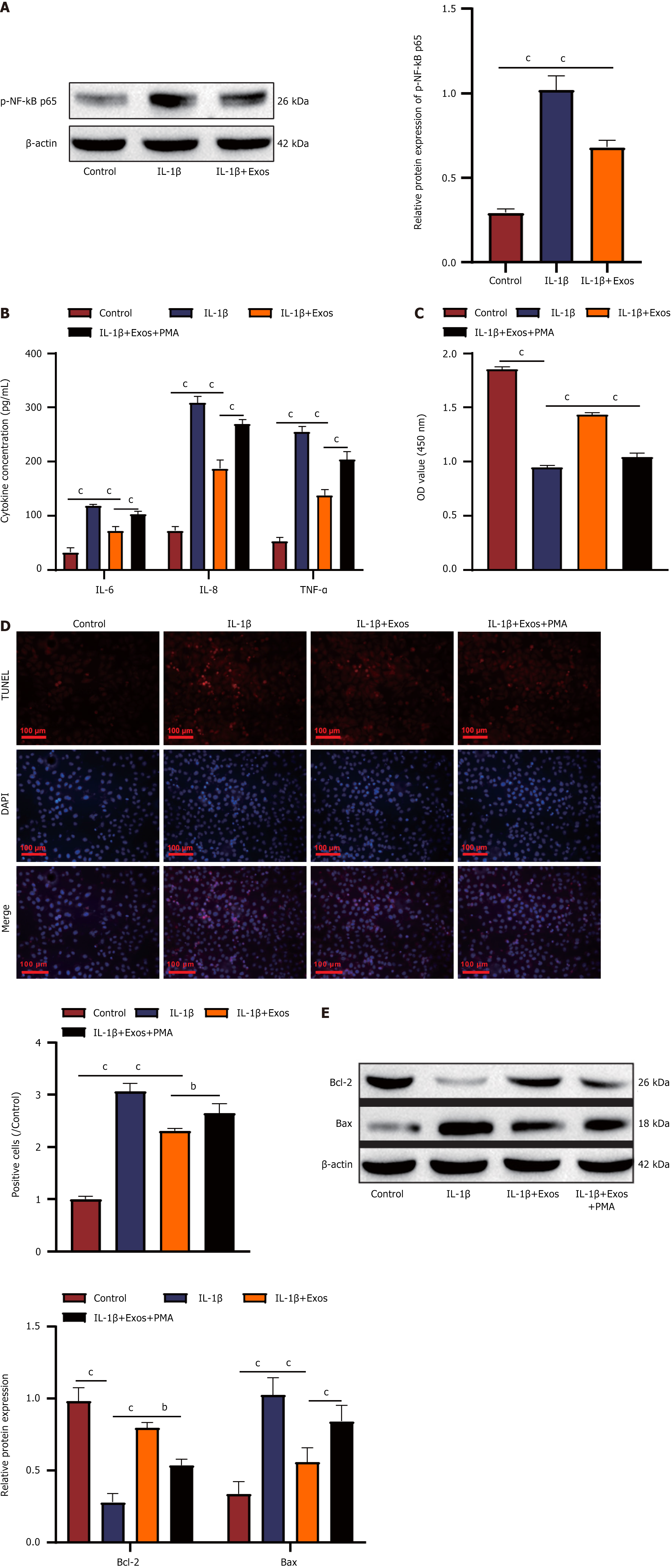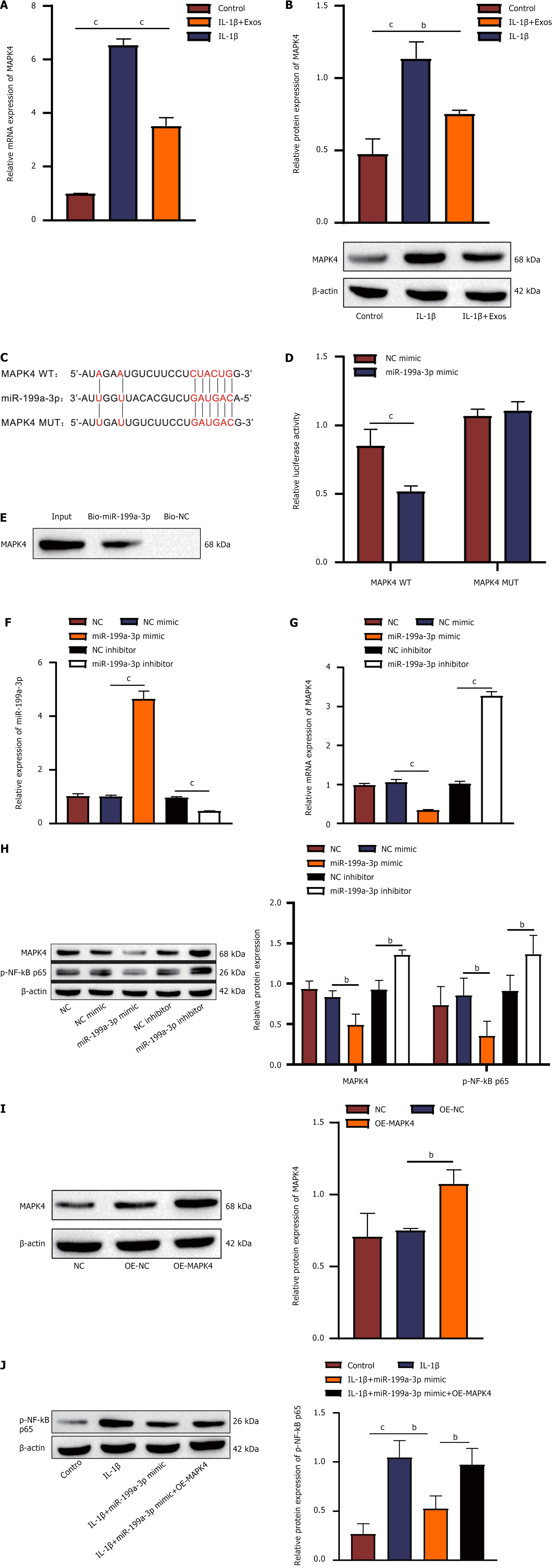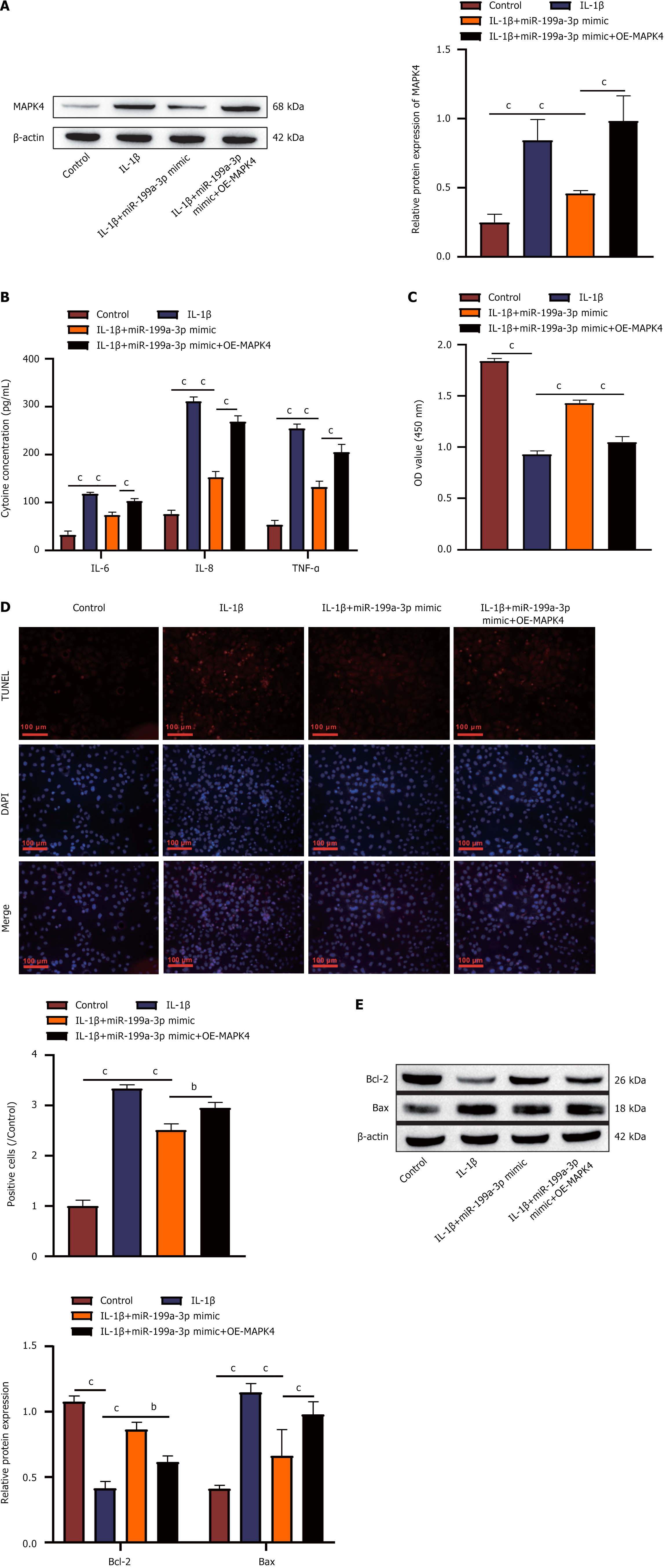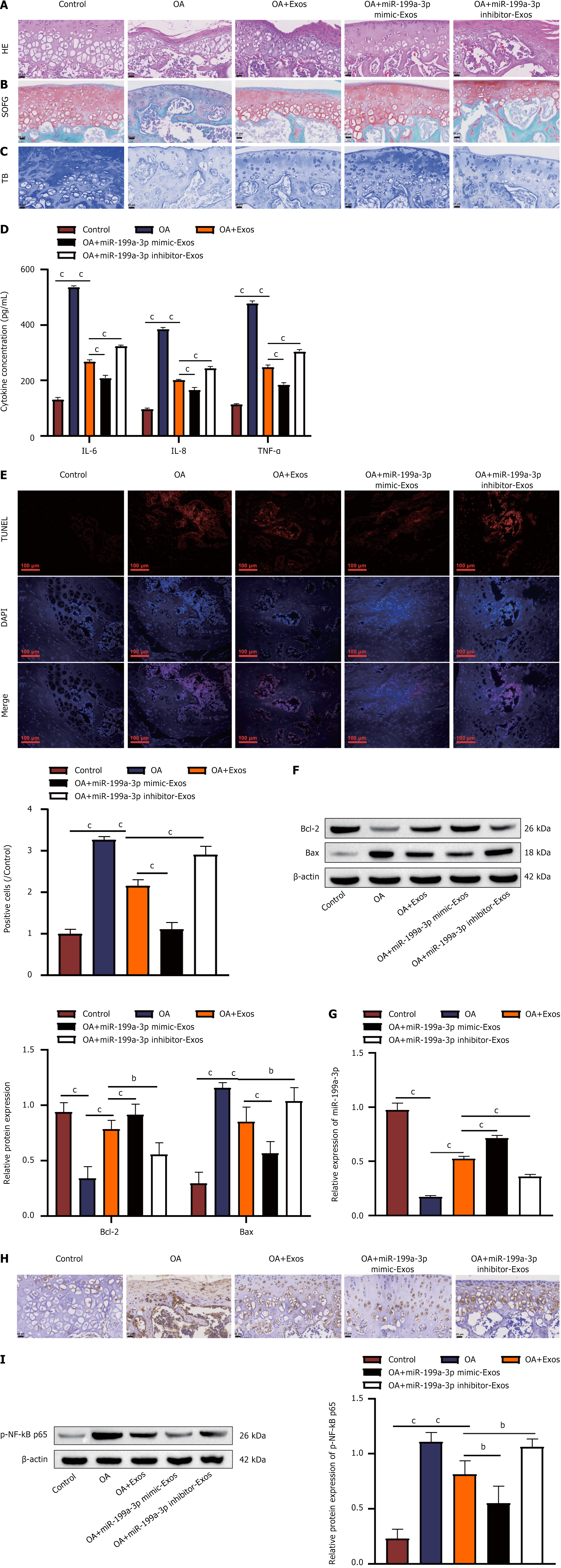Copyright
©The Author(s) 2025.
World J Stem Cells. Apr 26, 2025; 17(4): 103919
Published online Apr 26, 2025. doi: 10.4252/wjsc.v17.i4.103919
Published online Apr 26, 2025. doi: 10.4252/wjsc.v17.i4.103919
Figure 1 Human umbilical cord mesenchymal stem cell-derived exosomes relieve interleukin-1β-induced inflammation and apoptosis in chondrocytes.
A: Transmission electron microscopy images of the human umbilical cord mesenchymal stem cell-derived exosomes (scale bar = 100 nm); B: Particle size distribution of the purified human umbilical cord mesenchymal stem cell-derived exosomes determined by nanoparticle tracking analysis; C: Detection of CD63 and CD81 exosome surface markers by western blot analysis; D: PKH-67 tracking experiments verified the uptake of exosomes by CHON-001 cells (scale bar = 10 μm); E: Enzyme-linked immunosorbent assay was used to detect interleukin-6, interleukin-8, and tumor necrosis factor-α in CHON-001 cells; F: CCK-8 detection of CHON-001 cell viability; G: Apoptosis of CHON-001 cells detected via terminal deoxynucleotidyl transferase-mediated deoxyuridine triphosphate-nick end labelling staining (scale bar = 100 μm); H: In CHON-001 cells, Bcl-2 and Bax expression levels were detected by western blot analysis. aP < 0.05, bP < 0.01, cP < 0.001. hUC-MSCs: Human umbilical cord mesenchymal stem cells; Exos: Exosomes; DAPI: 4’,6-diamidino-2-phenylindole; IL: Interleukin; TNF: Tumor necrosis factor; OD: Optical density; TUNEL: Terminal deoxynucleotidyl transferase-mediated deoxyuridine triphosphate-nick end labelling.
Figure 2 Human umbilical cord mesenchymal stem cell-derived exosomes relieve interleukin-1β-induced chondrocyte inflammation and apoptosis through the delivery of miR-199a-3p.
A: Differential expression of microRNAs (miRNAs) in osteoarthritis was analyzed by heat and volcano maps; B: The expression levels of miR-199a-3p in CHON-001 cells were assessed via quantitative real-time polymerase chain reaction (qRT-PCR); C: The expression levels of miR-199a-3p in human umbilical cord mesenchymal stem cells and exosomes was detected by qRT-PCR; D: The efficiency of miR-199a-3p transfection was assessed in human umbilical cord mesenchymal stem cells via qRT-PCR; E: QRT-PCR analysis was conducted to determine the expression levels of miR-199a-3p in CHON-001 cells; F: An enzyme-linked immunosorbent assay was used to measure the interleukin-6, interleukin-8, and tumor necrosis factor-α levels in CHON-001 cells; G: The survival rate of CHON-001 cells was evaluated via CCK-8; H: Apoptosis was assessed through terminal deoxynucleotidyl transferase-mediated deoxyuridine triphosphate-nick end labelling staining (scale bar = 100 μm); I: The levels of the Bcl-2 and Bax apoptosis-related proteins were detected in CHON-001 cells using western blot analysis. aP < 0.05, bP < 0.01, cP < 0.001. hUC-MSCs: Human umbilical cord mesenchymal stem cells; Exos: Exosomes; NC: Normal control; NC mimic: Negative control mimic; NC inhibitor: Negative control inhibitor; DAPI: 4’,6-diamidino-2-phenylindole; OD: Optical density; IL: Interleukin; TNF: Tumor necrosis factor; TUNEL: Terminal deoxynucleotidyl transferase-mediated deoxyuridine triphosphate-nick end labelling.
Figure 3 Activation of the nuclear factor-kappaB signaling pathway attenuates the protective effect of human umbilical cord mesenchymal stem cell-derived exosomes on chondrocytes.
A: P-nuclear factor-kappaB p65 expression in CHON-001 cells was determined using western blot analysis; B: Interleukin-6, interleukin-8, and tumor necrosis factor-α levels in CHON-001 cells were determined via enzyme-linked immunosorbent assay; C: A CCK-8 assay was used to assess the viability of CHON-001 cells; D: Terminal deoxynucleotidyl transferase-mediated deoxyuridine triphosphate-nick end labelling staining was used to detect apoptosis in CHON-001 cells (scale bar = 100 μm); E: Bcl-2 and Bax apoptosis-related proteins in CHON-001 cells were detected via western blot analysis. bP < 0.01, cP < 0.001. NF-κB: Nuclear factor-kappaB; IL: Interleukin; TNF: Tumor necrosis factor; Exos: Exosomes; PMA: Phorbol 12-myristate 13-acetate; DAPI: 4’,6-diamidino-2-phenylindole; OD: Optical density; TUNEL: Terminal deoxynucleotidyl transferase-mediated deoxyuridine triphosphate-nick end labelling.
Figure 4 MiR-199a-3p inhibits the activation of the nuclear factor-kappaB signaling pathway by targeting mitogen-activated protein kinase 4.
A: The level of mitogen-activated protein kinase 4 (MAPK4) mRNA in CHON-001 cells was measured via quantitative real-time polymerase chain reaction; B: Western blot analysis was used to evaluate MAPK4 protein expression in CHON-001 cells; C: StarBase (http://starbase.sysu.edu.cn/) was used to predict the specific binding sites of miR-199a-3p and MAPK4; D: Dual-luciferase reporter assays validated the interaction between miR-199a-3p and MAPK4; E: The interaction of miR-199a-3p with MAPK4 was confirmed by RNA pull-down assays; F: Quantitative real-time polymerase chain reaction was used to assess the miR-199a-3p transfection efficiency in CHON-001 cells; G: The expression levels of MAPK4 mRNA in CHON-001 cells were evaluated via quantitative real-time polymerase chain reaction; H: Western blot analysis was conducted to evaluate the expression levels of MAPK4 and p-nuclear factor-kappaB p65 in CHON-001 cells; I: Western blot analysis was used to assess the effectiveness of MAPK4 transfection in CHON-001 cells; J: Western blot analysis was used to examine the expression levels of p-nuclear factor-kappaB p65 in CHON-001 cells. bP < 0.01, cP < 0.001. MAPK4: Mitogen-activated protein kinase 4; IL: Interleukin; Exos: Exosomes; NC: Normal control; NC mimic: Negative control mimic; NC inhibitor: Negative control inhibitor; OE-NC: Overexpression negative control; OE-MAPK4: Overexpression mitogen-activated protein kinase 4; NF-κB: Nuclear factor-kappaB.
Figure 5 Overexpression of mitogen-activated protein kinase 4 attenuates the effects of miR-199a-3p on inflammation and apoptosis in chondrocytes.
A: Mitogen-activated protein kinase 4 expression was detected by western blot; B: Interleukin-6, interleukin-8, and tumor necrosis factor-α expression in CHON-001 cells was detected via enzyme-linked immunosorbent assay; C: A CCK-8 assay was used to measure the viability of CHON-001 cells; D: Terminal deoxynucleotidyl transferase-mediated deoxyuridine triphosphate-nick end labelling staining was used to measure the degree of CHON-001 cell apoptosis (scale bar = 100 μm); E: Western blot analysis was used to detect Bcl-2 and Bax apoptosis-related proteins in CHON-001 cells. bP < 0.01, cP < 0.001. MAPK4: Mitogen-activated protein kinase 4; IL: Interleukin; OE-MAPK4: Overexpression mitogen-activated protein kinase 4; DAPI: 4’,6-diamidino-2-phenylindole; OD: Optical density; TUNEL: Terminal deoxynucleotidyl transferase-mediated deoxyuridine triphosphate-nick end labelling.
Figure 6 Human umbilical cord mesenchymal stem cell-derived exosomes relieve osteoarthritis progression in vivo through the delivery of miR-199a-3p.
A: Hematoxylin and eosin staining was used to examine the pathological conditions of rat articular cartilage tissues (scale bar = 25 μm); B: Safranin O/fast green staining was used to assess the quantity of chondrocytes within rat articular cartilage tissues (scale bar = 25 μm); C: Examination of cartilage differentiation in rat articular cartilage tissues via toluidine blue staining (scale bar = 25 μm); D: Interleukin-6, interleukin-8, and tumor necrosis factor-α levels in rat articular cartilage tissue were detected via enzyme-linked immunosorbent assay; E: Evaluation of cell apoptosis in rat articular cartilage tissue via terminal deoxynucleotidyl transferase-mediated deoxyuridine triphosphate-nick end labelling staining (scale bar = 100 μm); F: Western blot analysis was used to measure the expression of Bcl-2 and Bax apoptosis-related proteins; G: Quantitative real-time polymerase chain reaction was used to quantify miR-199a-3p expression in rat cartilage tissues; H: Immunohistochemistry was used to determine the presence of mitogen-activated protein kinase 4 in rat articular cartilage tissues (scale bar = 25 μm); I: P-nuclear factor-kappaB p65 expression in rat articular cartilage tissues was evaluated through western blot analysis. bP < 0.01, cP < 0.001. OA: Osteoarthritis; Exos: Exosomes; HE: Hematoxylin and eosin; TB: Toluidine blue; SOFG: Safranin O/fast green; NF-κB: Nuclear factor-kappaB; IL: Interleukin; TNF: Tumor necrosis factor; DAPI: 4’,6-diamidino-2-phenylindole; TUNEL: Terminal deoxynucleotidyl transferase-mediated deoxyuridine triphosphate-nick end labelling.
- Citation: Chen LQ, Ma S, Yu J, Zuo DC, Yin ZJ, Li FY, He X, Peng HT, Shi XQ, Huang WJ, Li Q, Wang J. Human umbilical cord mesenchymal stem cell-derived exosomal miR-199a-3p inhibits the MAPK4/NF-κB signaling pathway to relieve osteoarthritis. World J Stem Cells 2025; 17(4): 103919
- URL: https://www.wjgnet.com/1948-0210/full/v17/i4/103919.htm
- DOI: https://dx.doi.org/10.4252/wjsc.v17.i4.103919














